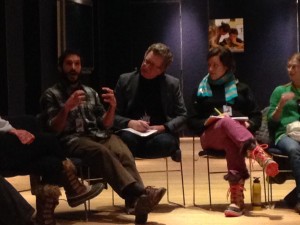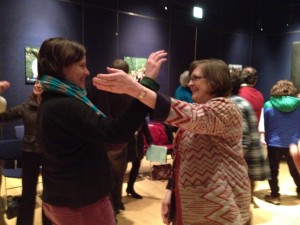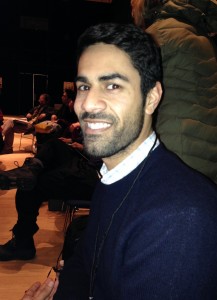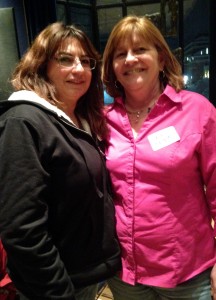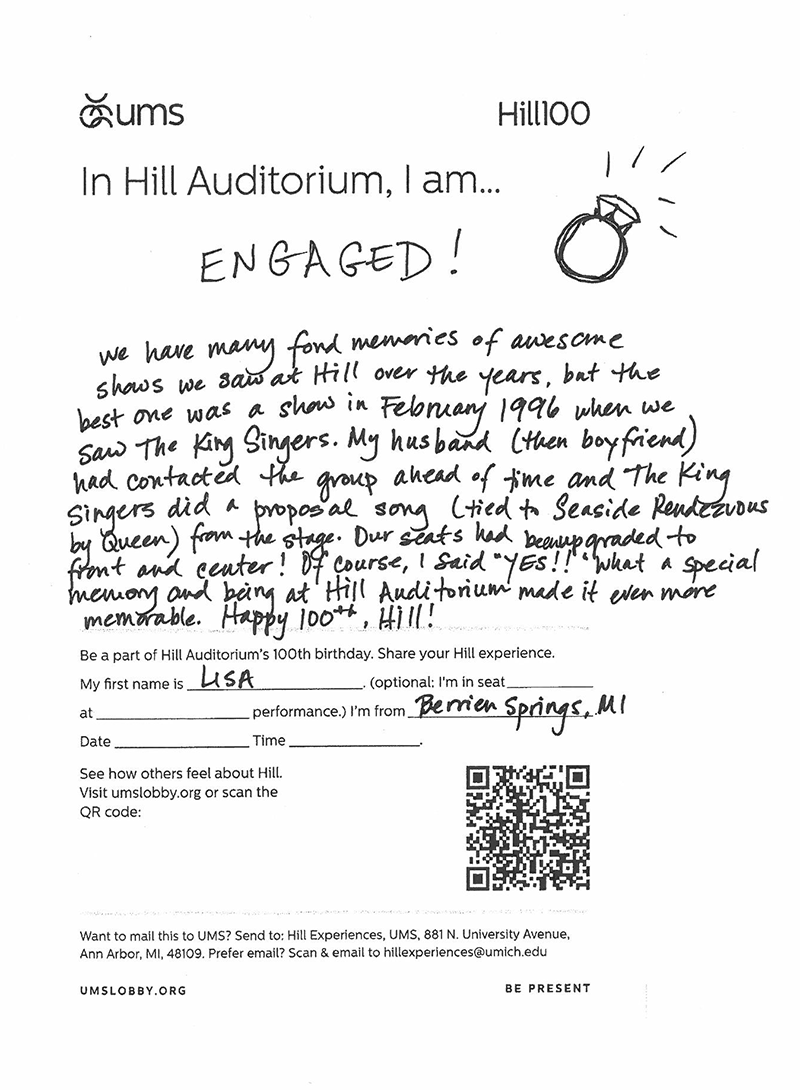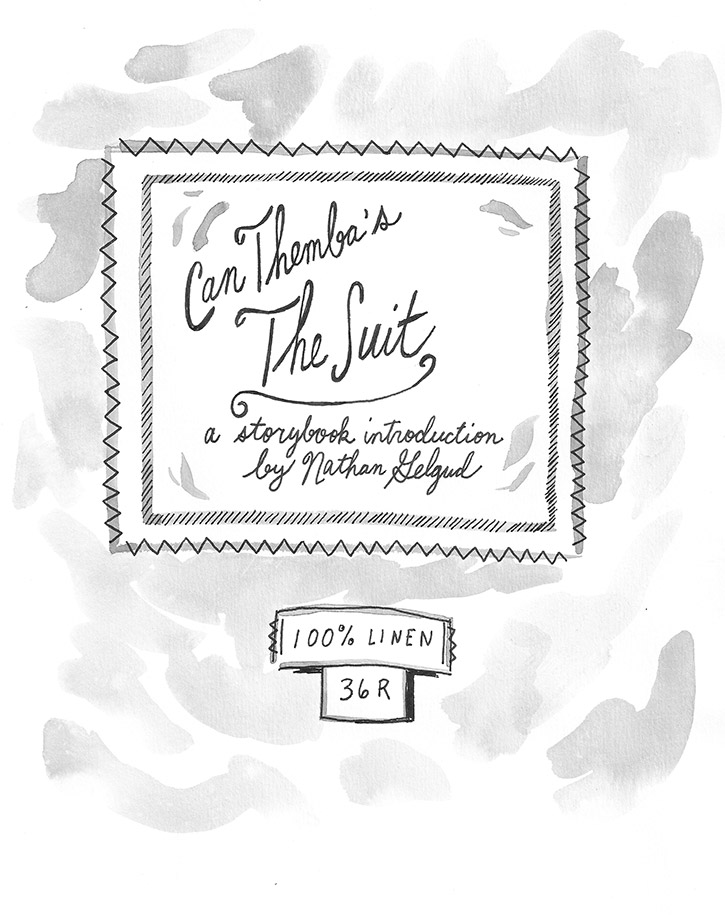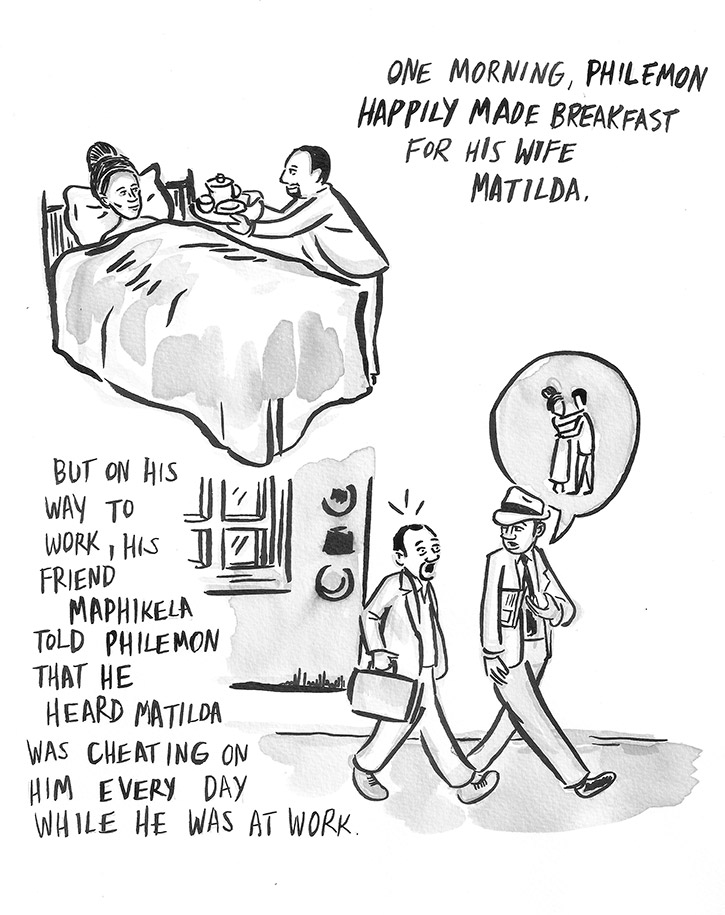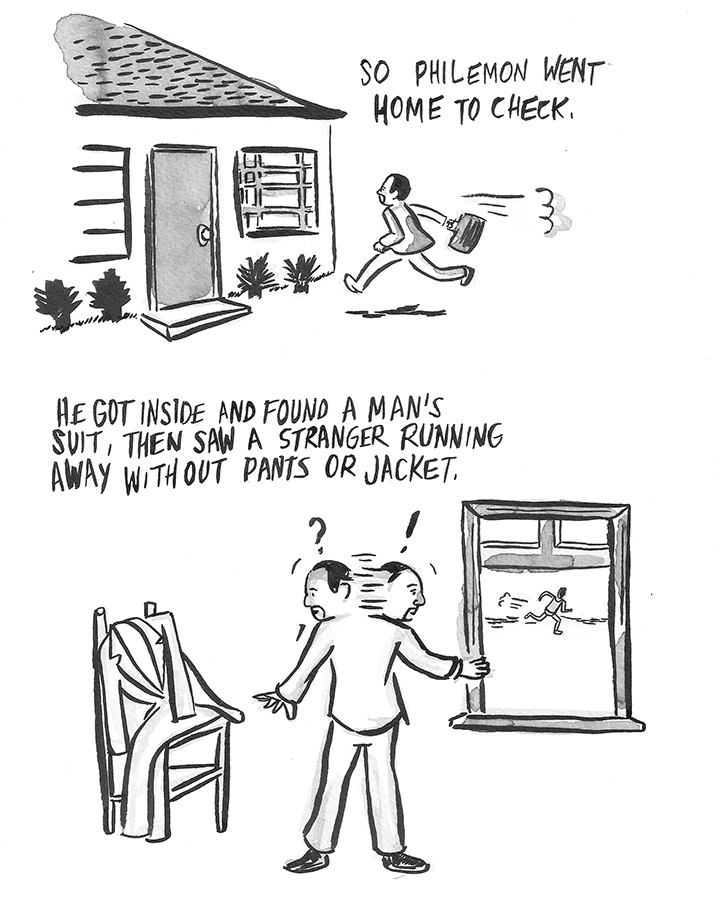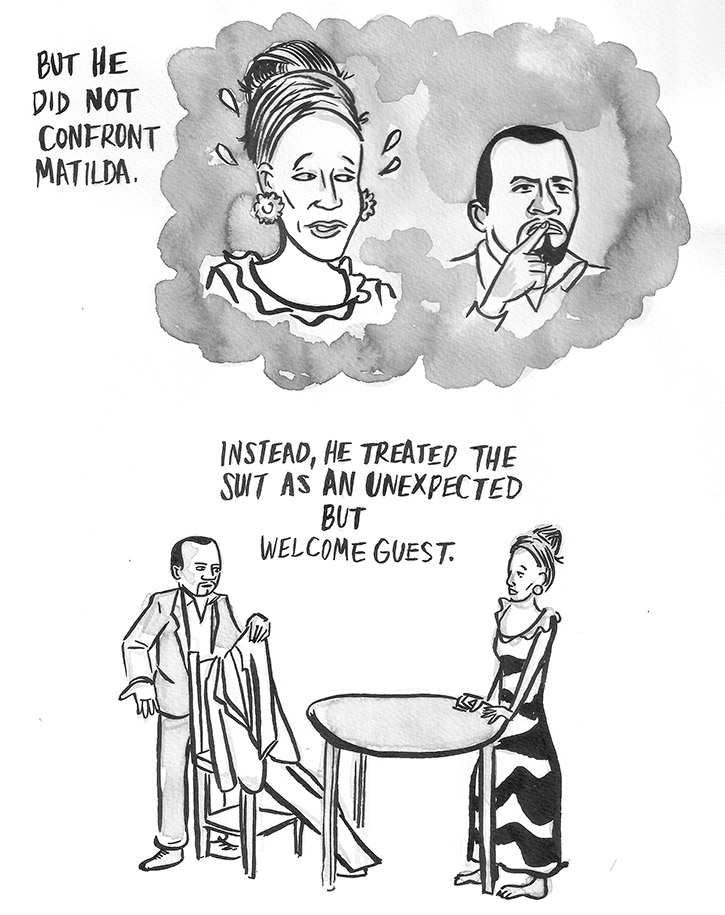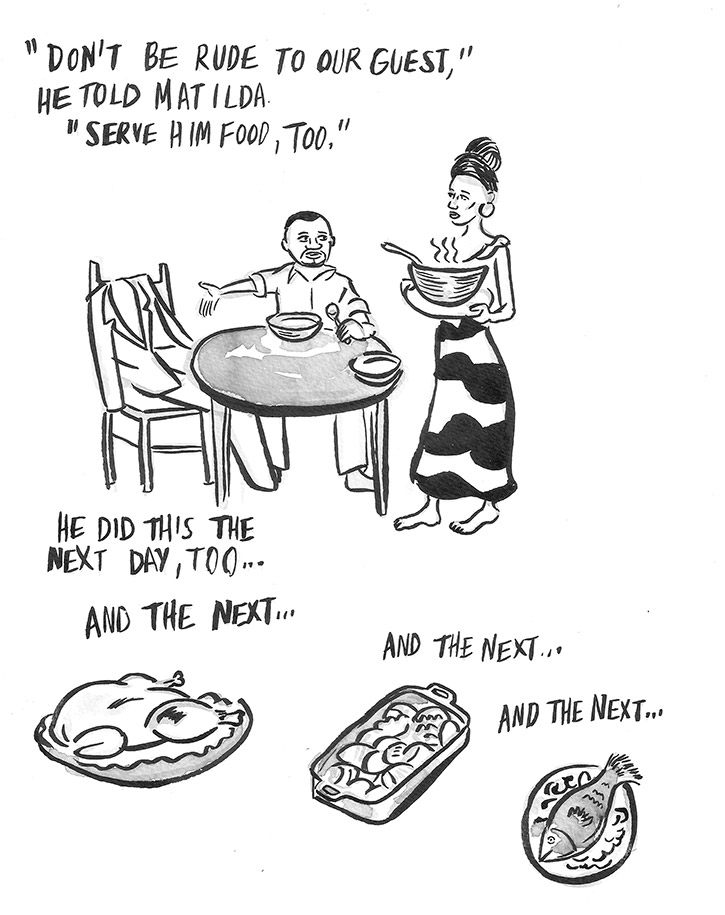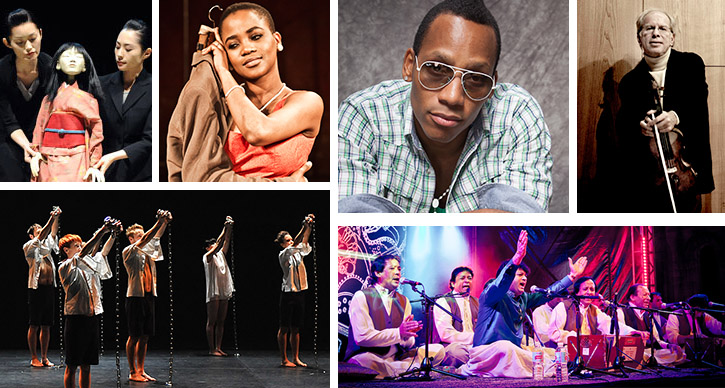UMS Night School: Bodies in Motion – Session 5 Recap
Editor’s note: This post is a part of a series of by U-M student Sarah Squillante, who’s covering our free UMS Night School: Bodies in Motion series. Learn along side with them.
Educationally rich. Inspiring. Moving. Authentic. Sharing. These are just a few of the many words UMS Night School attendees provided when asked to summarize their experiences thus far.
“This is making me think so much more deeply about the play,” said Sharman Spieser.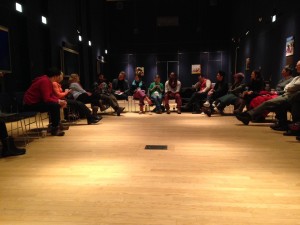
Sharman’s comment was just one among many in a discussion of Théâtre des Bouffes du Nord’s production of The Suit that opened up Monday’s session, led by U-M Professor of Theatre, Jillian Eaton.
Points of reflection concerned the transformation of the play from a short story, the significance of music, the development of the main female character, the subtlety of apartheid undertones, and, of course, movement.
“[Movement] was not a layer that was added on. It was at the core of the performance,” said one attendee.
Host Clare Croft asked attendees how they connected physically with the performance. This was a night school session devoted to Bodies in Motion, after all. Attendees were invited to share how they physically reacted to certain moments, and how they thought they would feel if they were one of the audience members pulled on stage during the audience participation moment in the performance.
“What I’ve learned the most at night school is how movement is a part of everything that you do,” said Lisa Beard.
The session moved to a discussion with this question at its center: What does it mean to experiment in motion? U-M Associate Professor Dance, Amy Chavasse, got bodies moving instead lips, this time using an exercise in which pairs of two walked toward each other, slowly writing their names in the air with a body part. The room buzzed with discussion as soon as the lines collided.
U-M Associate Professor of American Culture, Larry La Fountain-Stokes, emphasized the value in performances that break the dance mold, specifically in regard to the traditional male/female stereotype. One such performance is the upcoming RMW (a)/RW and Toe, performances by DD Dorvillier and Jennifer Monson, performances that came out of a conference called Meanings and Makings of Queer Dance Research. The shows will be performed in the U-M Duderstadt Center Video Studio on North Campus on February. 26 and 27 at 7:30 PM.
The pleasure and value of experimentation was summed up by Clare Croft, who said, “I find that the kinds of performances I like the most are those when I end up saying what’s going on? What’s going on? What’s going on? This is awesome.”
Night School is taking a short break and will resume on Monday, March 10 at 7 PM in the U-M Alumni Center. Our sixth session, entitled “Bodies Make Music,” will delve into the movement of musicians and prepare attendees for the Israel Philharmonic Orchestra.
Interested in even more dance engagement? Pick up an adventure card to learn all about the dance activities we’re offering this year and for a chance to win a backstage meet and greet.
Session Resources
- UMS Bodies in Motion Session 5 – Key Theme, Players, and Definitions [Word Document assembled by Marcus White, MFA Candidate – Dance, University of Michigan]
Share questions, comments, or suggestions in the comments below.
UMS Night School: Bodies in Motion – Session 4 Recap
Editor’s note: This post is a part of a series of by U-M student Sarah Squillante, who’s covering our free UMS Night School: Bodies in Motion series. Learn along side with them.
Does a discussion of theatre belong in a Night School series devoted to dance? Is there a place for opera, on-stage violence, even music? After Monday’s UMS Night School session, most attendees would probably say that it does.
Host Clare Croft reminded attendees that there are multiple ways to enter a performance. Even in theatre, she said, it’s useful to pay attention to movement and ask ourselves: How are performers using the space? What can we learn about the characters from how they move or stand? She introduced four speakers who offered their personal take on the upcoming performance of Théâtre des Bouffes du Nord’s production of The Suit, directed by Peter Brook.
Naomi Andre, U-M Associate Professor of Women’s Studies, explained the significance of South African opera, reminding participants of dance-like qualities of voice performance. UMS Campus Engagement Specialist, Shannon Fitzsimons, spoke about legendary theatrical director Peter Brook, and touched on his “sense of visual economy” and “commitment to emotional truth,” among other details. UMS Director of Programming, Michael Kondziolka, touched on his skepticism before seeing the performance for the first time and his reasons for selecting the piece. He noted that it is really “telling a story about the movement of bodies.” Finally, Rob Najarian, U-M Assistant Professor of Theatre and former fight/violence director, encouraged attendees to think about the “shared experience” between audience and performer. He led a movement exercise that illustrated the deliberate nature of movement.
Attendees also had a chance to reflect on the past weekend’s performances of Compagnie Kafig, demonstrating a movement that embodied the show to share with the group; many found that the troupe had an incredible amount of athleticism and humor.
One attendee noted that her experience at the You Can Dance workshop affected her viewing of Compagnie Käfig: “It wasn’t the type of move that makes you go to your friends and say, ‘wow did you see that?’ but I really noticed the intricacy and complexity in movements that seem so simple,” U-M graduate and frequent Night School attendee Sasha Kapshai said.
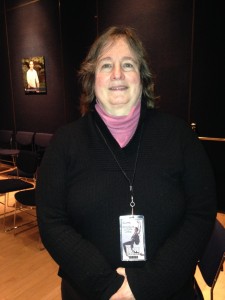
Attendee Jane Michener didn’t have plans to see The Suit before the evening, but then changed her mind. “I’m intrigued by all the intricacies of how it’s put together,” she said.
Session 5 of Night School, Body Experiments, will explore ways in which dancers experiment and create new ideas in dance, preparation for Jennifer Monson and DD Dorvillier’s RMW(a)/RMW, and discussion of The Suit. Special guests include: Anita Gonzalez, U-M Professor of Theatre and Drama, Amy Chavasse, U-M Associate Professor of Dance, Larry La Fountain-Stokes, U-M Associate Professor of American Culture, Gillian Eaton, U-M Assistant Professor of Theatre, and Rob Najarian, U-M Assistant Professor of Theatre.
The upcoming weekend is full of dance-related viewing opportunities! Check out the Dance on Camera Festival at the University of Michigan Museum of Art and the UMS performance of Théâtre des Bouffes du Nord: The Suit, 2/19-2/22 at the Power Center.
Session 4 Resources
- Excerpt from Peter Brook’s The Open Door
Interested in even more dance engagement? Pick up an adventure card to learn all about the dance activities we’re offering this year and for a chance to win a backstage meet and greet.
For a complete list of 2013-2014 dance performances, visit ums.org. Share questions, comments, or suggestions in the comments below.
U-M Theater Community on Peter Brook’s The Suit
Director Peter Brook changed contemporary theater. His production of The Suit will be in Ann Arbor on February 19-22, 2014. We chat with University of Michigan faculty, as well as with former Royal Shakespeare Company director Michael Boyd, about why they’re excited to see the production and the importance of Brook’s work:
Interested in learning more? Check out our infographic of the highlights of Brook’s life and work.
UMS Night School: Bodies in Motion – Session 3 Recap
Editor’s note: This post is a part of a series of by U-M student Sarah Squillante, who’s covering our free UMS Night School: Bodies in Motion series. Learn along side with them.
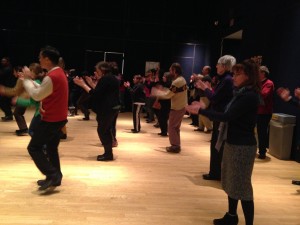
UMS Night School attendees danced to a new beat this week – literally. Midway through the session, attendees were asked to get up on their feet, learn a basic Capoeira step, and then free-style in a large circle to funk music. The movement exercise, led by U-M Dance MFA Candidate Marcus Whiten, gave attendees a kinesthetic taste of a distinct style – a mix of hip hop, martial arts, and acrobatics – that Compagnie Käfig will bring to Ann Arbor this weekend, February 14 and 15.
This week also marked the beginning of a new format in which attendees have the opportunity to discuss a recent dance performance. This week’s discussion centered around “Moving Pictures,” a concert featuring 4 works performed by the U-M department of Dance. In a short panel discussion, three dancers spoke first of the larger ideas that they were asked to conceptualize during the beginning stages of the pieces, then progressed to more specific elements of the performance, like costuming and live music. The dancers expressed delight in the challenges that the pieces provided and in the connections that they were able to make with the audience.
The attendees comprised a diverse a group as usual, ranging from experienced dancers to those who had never seen a performance before. The class has grown significantly since the first week. Some have become Night School “regulars,” while others ventured out into the cold for the first time.
In the left photo, newcomer Razi Jafri said he came because he “didn’t really know anything about dance – artistically or technically,” so he figured it’d be a good introduction.
On the right, Lucie Cohen and Deb Taylor came to Night School thinking they’d be seeing a dance performance, but were pleasantly surprised by the discussion format. “I really enjoyed getting involved when we started moving. The proximity of our bodies made me feel like I knew people on a personal level,” Lucia said.
Leslie Woldenberg, a dance lover and frequent UMS patron, drove all the way from Toledo with a friend to experience Night School for the first time.
The session finished with a short talk from Reighan Gillam, Postdoctoral research fellow in the U-M Department of Afroamerican and African Studies, who spoke about the origins of hip-hop music and dance in Brazil. Gillam emphasized the fact that rappers come from the periphery of Brazil and that, much like hip hop in the United States, the content typically revolves around the violence and system inequality characteristic of marginalized groups.
The details – and the questions they inspired – were intended to help attendees frame their viewing of Compagnie Käfig. Night School host Clare Croft suggested that attendees use information from the lecture to consider how the atmosphere in Brazil may impact the movement they see on stage.
The fourth session of Night School will include an exploration of how actors think about movement, with a preparation for Théâtre des Bouffes du Nord’s The Suit, and also a discussion of Compagnie Käfig’s Correria Agwa. Special guests will include: Naomi Andre, U-M Associate Professor of Women’s Studies, Rob Najarian, U-M Assistant Professor of Theatre, and Michael Kondziolka, UMS Director of Programming. It will be held at the U-M Alumni Center at 200 Fletcher Street at 7 PM.
Session 3 Resources & Readings
- UMS Learning Guide on Compagnie Käfig
- Performance prep reading on Capoeira – “Headspin” by Barbara Browning
- Bodies in Motion Session 3 – Key Themes, Players, and Definitions [Word Document assembled by Marcus White, MFA Candidate – Dance, University of Michigan]
- Session 4 Prep Reading: Excerpt from Peter Brook’s The Open Door
Interested in even more dance engagement? Pick up an adventure card to learn all about the dance activities we’re offering this year and for a chance to win a backstage meet and greet.
For a complete list of 2013-2014 dance performances, visit ums.org. Share questions, comments, or suggestions in the comments below.
Putting On “The Suit”
Editor’s note: Student volunteers at UMS often get the chance to take a deep dive into a performance or art form. In this essay, UMS Marketing intern Clare Brennan reflects on her experiences with “The Suit” directed by the legendary stage and film director Peter Brook. The performance will be at Ann Arbor’s Power Center on February 19-22, 2014.
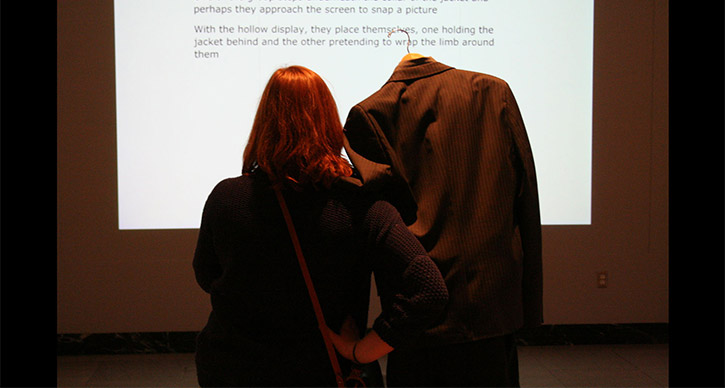
Photo: Clare Brennan and the UMS Student Committee take the suit around town as part of U-M Museum of Art’s “Love Art More” project. Photo by UMS Student Committee.
It’s not hard for me to remember one of the first books that really moved me. I was sitting in my living room, home alone on a bright August afternoon, finishing up some reading I’d been assigned for my last year of English in high school. I read the final paragraph, closed the back cover, and sat quietly for a while. I might’ve teared up a bit, if I’m being honest. The book was Alan Paton’s Cry, The Beloved Country, and it was then that I became infatuated with the stories and storytellers from South Africa.
As it turns out, my love for the French language and culture was growing right alongside this, as well as an absolute obsession with all things regarding Anglo-Saxon theater. Imagine, then, my elation when an opportunity to dive head first into The Suit fell into my lap. My nerdy heart fluttered. I accepted as nonchalantly as I could.
Apparently, my fixation with The Suit is not uncommon. Legendary theatrical director Peter Brook loved this story so much that, after directing the story once in French in 1999, he chose to return to it, this time in English. I had the chance to sit down with Michael Kondziolka, the Director of Programming here at UMS. He saw the debut of this production of The Suit last year in New York, and knew that Ann Arbor had to have the chance to see it. “It’s so painterly. A supreme colorist can use shadow and light and color and understands exactly how to use these different media to create a masterpiece. That’s what Peter Brook is doing. He knows how to use actors and written text and music and light and staging and movement and the audience, and how to craft all of that into something that is really powerful, really masterful.”
Of course, any discussion of South Africa must mention the recent passing of Nelson Mandela. The Suit is set on the cusp of Mandela’s most prominent years, and this energy of anticipation of what’s to come silently fills the stage. It provides an opportunity to see a South Africa without Mandela and his work, and as the world reflects on his incredible dedication to his country, taking a moment to step back and hear from those who came before him feels even more powerful.
With that context, The Suit might seem like a eulogy. Far from it. In talking with Michael, I got the chance to hear about what makes a Peter Brook piece tick. At the heart of each of his works is a dedication to simplicity. “This piece has a real lightness to it. And the lightness comes from the performance.” Over almost half- century of work, Brook has pared down his stages, from the intricate scenery of his staging of the Bard for the Royal Shakespeare Company to the openness of The Suit’s space. “It creates a sense of the fun of the performance. So you’ve got this really interesting visual experience. Your imagination is unlocked as an audience member, and that’s really entertaining and satisfying.” Brook trusts his audience, an honor not frequently given, and we’re free to reap the benefits.
While we covered many topics, my chat with Michael really focused on the music embedded in the show. From Schubert on the accordion to a poignantly placed introduction of Bach’s St. Matthew’s Passion (what Michael reverently referred to as “The Sistine Chapel of classical music”), it is evident that Brook knows exactly how to carefully weave music into his work. “Peter Brook is not only a master theater maker but he clearly is a student of culture, and the way in which he understands the meaning of these specific pieces of music and uses them to get his theatrical idea across.”
Studying up for The Suit has been a joy. Peter Brook knows how to tell a story, and his ability to transcend the barriers of the stage and approach each member of the audience with this incredible story of love and loss has no comparison. I’m so looking forward to seeing this show and finding what discoveries I still have left to make. The stage has a magical quality, and, in The Suit, it’s clear that Peter Brook knows it. “It’s pure poetry,” as Michael eloquently sums up. From what I can tell, I think he’s on to something .
Interested in learning more? Check out a brief infographic history of Peter Brook’s career or watch a storybook introduction to the performance.
Sources:
http://www.bouffesdunord.com/en/about-us/peter-brook
http://frenchculture.org/visual-and-performing-arts/events/us-premiere-suit-directed-peter-brook
The Suit: A Storybook Introduction
The Suit will be at Ann Arbor’s Power Center on February 19-22, 2014. The play, directed by the renowned Peter Brook, is adapted from South African writer Can Themba’s witty, unsettling short story of the same name.
Our video is based on Brooklyn-based illustrator Nathan Gelgud’s “storybook” introduction to “The Suit.” Explore the stills from this video.
Take Our Quiz: Which UMS Performance is the Right Valentine’s Date for You?
Each year, UMS brings over 60 world-class performances to the Ann Arbor area. This year we’re lucky to have a diverse set of offerings right around Valentine’s Day weekend. How will you pick the right performance for you and your date? A handy quiz:
You never know what’ll happen. We received this Hill Auditorium memory last season:
Got a story about a date during a performance? Share it in the comments below.
A [brief] UMS History Presentation: Peter Brook
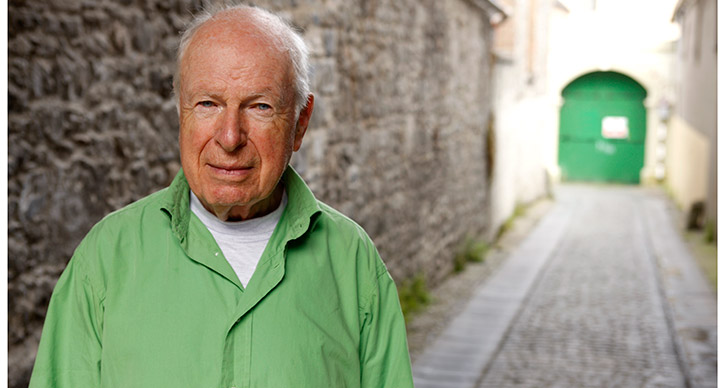
Photo: Peter Brook. Photo by Colm Hogan.
Director Peter Brook’s contributions to theater have spanned stage, film, and literary worlds. He directs The suit, performed by Théâtre des Bouffes du Nord at the Power Center in Ann Arbor February 19-22, 2014.
His legendary career has spanned decades and the world. Explore the timeline in this infographic:
The Suit: A Storybook Introduction
The Suit will be at Ann Arbor’s Power Center on February 19-22, 2014. The play, directed by the renowned Peter Brook, is adapted from South African writer Can Themba’s witty, unsettling short story of the same name.
Can Themba was a short story writer and journalist, writing investigative pieces for Drum Magazine in addition to fiction in the 1950s and sixties. Peter Brook’s 71-year career spanned the Royal Shakespeare Company, London’s West End, Paris’s Théâtre des Bouffes du Nord, and countless other companies and has irrevocably changed contemporary theater.
Brooklyn-based illustrator Nathan Gelgud has created a “storybook” introduction to The Suit.
See how things shape up on stage starting February 19. Tickets are on sale now.
These illustrations originally appeared on BAM blog. More: nathangelgud.com
Interested in reading the story? Get a special deal on the book and the performance through our UMS Book Club with Nicola’s Books.
UMS Book Club with Nicola’s Books
New this season, UMS is kicking off UMS Book Club. UMS and Nicola’s Books have teamed up to assemble a list of fiction, poetry, and non-fiction, matching six performances with books that carry similar themes, messages, or character traits. Get reading and dig deep into elements of the performance.
Here’s how to join
Pick up a book from the UMS Book Club list at Nicola’s Books (at a special discount of 15%) and unlock a special offer of up to 25% off to the related performances. Nicola’s Books is located at 2513 Jackson Avenue, Westgate Shopping Center, Ann Arbor, MI 48103.
You can use the code online at ums.org. You can also call our UMS Ticket Office at 734.764.2538 or visit the Michigan League Ticket Office. Be sure to mention the the promo code at the start of your order.
This offer is not valid on previously purchased tickets, in conjunction with any other offer, or at the door on the evening of the performance.
The books
 Book: Seven Japanese Tales by Jun’ichirō Tanizaki
Book: Seven Japanese Tales by Jun’ichirō Tanizaki
Performance: Complicite: Shun-kin, September 18-21, 2013 at Power Center
Inspired by the work of one of the most important Japanese writers of the 20th century, Jun’ichirō Tanizaki, Shun-kin tells a tale of devotion, passion, and power, where beauty is unforgiving and love is blinding.
 Book: The Age of Miracles by Karen Thompson Walker
Book: The Age of Miracles by Karen Thompson Walker
Performance: Ballet Preljocaj, November 1-2, 2013 at Power Center
And Then, One Thousand Years of Peace, which will be seen only at UMS, BAM, and Minneapolis, was first created by Angelin Preljocaj for the Bolshoi Ballet in 2010 and takes inspiration from the vision of apocalypse conjured by St. John in the biblical Book of Revelation. Karen Thompson Walker’s acclaimed novel is about a quieter apocalypse, when the Earth’s rotation slows, is a coming-of-age tale that clings to hope in light of a collapsing world.
 Book: Shostakovich: A Life Remembered by Elizabeth Wilson
Book: Shostakovich: A Life Remembered by Elizabeth Wilson
Performance: Kremerata Baltica, February 6, 2014 at Hill Auditorium
Kremerata Baltika will perform Shostakovich’s Anti-formalist Gallery, a dangerously satirical cantata never intended to be published or performed, as it would have imperiled his safety. In her biography of the composer, Elizabeth Wilson covers the discrepancies between Shostakovich’s public image and private life “from his early successes to his struggles under the Stalinist regime, and his international recognition as one of the leading composers of the twentieth century” through the reminiscences of his contemporaries and his personal writings.

Performance: Théâtre des Bouffes du Nord: The Suit, February 19-22, 2014 at Power Center
Peter Brook’s tender production makes Can Themba’s tightly crafted, unsettling fable sing. African melodies and Schubert lieder thicken the air of this apartheid-era summer in which a shared wound is not allowed to heal. This collection of stories from the African continent, presenting many different visions of Africa and reflecting on the continent’s tragic, imperialized history, includes Can Themba’s fable.
 Book: Tropicana Nights: The Life and Times of the Legendary Cuban Nightclub Paperback by Rosa Lowinge
Book: Tropicana Nights: The Life and Times of the Legendary Cuban Nightclub Paperback by Rosa Lowinge
Performance: Alfredo Rodríguez Trio and Pedrito Martinez Group, March 14, 2014 at Michigan Theater
This double-bill performance features percussionist and vocalist Pedrito Martinez, who incorporates the folklore of his Cuban roots with religious Yoruba chants and batá melodies into the traditional clave beat of popular Latin jazz, and Cuban-born Alfredo Rodríguez, a young pianist of astonishing virtuosity and imagination, performs with the open spirit of a culture rooted in dancing. These musicians represent a new generation of Cuban-influenced music, while Rosa Lowinge’s Tropicana Nights is a window into the culture and history of pre-Revolutionary Cuba through Havana’s notorious Tropicana nightclub, an estate frequented by legends like Nat “King” Cole, Liberace, Josephine Baker, and Ernest Hemingway.
 Book: The Essential Rumi
Book: The Essential Rumi
Performance: Asif Ali Khan Qawwali Music of Pakistan, March 21, 2014 at Rackham Auditorium
If the late, great Nusrat Fateh Ali Khan (1948-97) was known as “the emperor of Qawwali,” Asif Ali Khan — who was once hailed by the maestro as one of his best students — has surely emerged as the music’s reigning prince. Asif is a superstar in his native Pakistan and a powerful figure on the international stage, remaining faithful to the sublime traditions of devotional Sufi music. Rumi is perhaps the most well-known exponent of Sufi poetry; both spiritual and carefully crafted, these poems aim to reveal the human soul.
Did you read one of these books and attend the related performance? Share your thoughts or questions in the comments below.


